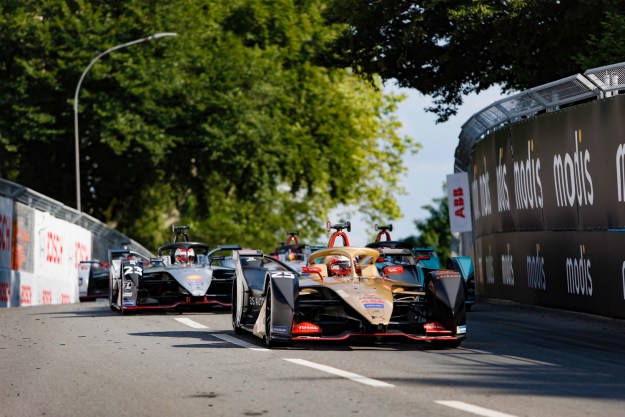The list of Hollywood actors who have transitioned to motor sports includes famous names like Steve McQueen and Paul Newman. Chris Hemsworth recently test drove a Formula E race car, so can he add his name to that list?
The actor best known for playing Thor got behind the wheel of one of Formula E’s electric race cars during the recent New York City ePrix (that’s what Formula E calls its races). While he seemed to have fun, Hemsworth probably didn’t have any of Formula E’s pro drivers worrying about their jobs.
Hemsworth played Formula One legend James Hunt in the 2013 film Rush, but that doesn’t seem to have helped his driving skills. He spun the car in one turn, and drove at a fairly leisurely pace for the rest of the lap. At least he managed to avoid hitting the wall, which can be difficult on the tight NYC ePrix track. Formula E uses temporary street circuits rather than conventional racetracks, and the New York circuit was laid out within the confines of a customs facility in Brooklyn.
“I was a little too excited, just got a little overconfident … I was just happy I found reverse and was able to get back going,” Hemsworth said of the spin. “It’s the first time I’ve done it, so that’s my excuse for all the mistakes I made!” Overall, Hemsworth said the drive was “good fun.”
Hemsworth wasn’t the only celebrity ready to take the wheel at the NYC ePrix, which was the first major motor sport event held within New York’s city limits in modern times. Richard Branson, whose Virgin conglomerate sponsors one of the teams, volunteered himself as a reserve driver. He wasn’t needed, as DS Virgin Racing driver Sam Bird won both rounds of the doubleheader in the Big Apple.
Formula E’s next stop is Montreal, where a pair of races will be run July 29 and 30. That will bring an end to the current season, with teams getting a few months off before the next season kicks off in Hong Kong in December. That season, Formula E’s fourth, will be the last before sweeping rules changes meant to improve the quality of the racing take effect for the 2018-2019 season.
Editors' Recommendations
- Formula E driver caught using a pro gamer in virtual race
- Formula E team rolls with marble racing during pandemic postponement
- Formula One teams are using racing tech to tackle coronavirus
- Opel is creating an electric car rally racing series for Europe
- 2019 Audi E-Tron is the first electric car to earn top IIHS safety rating


